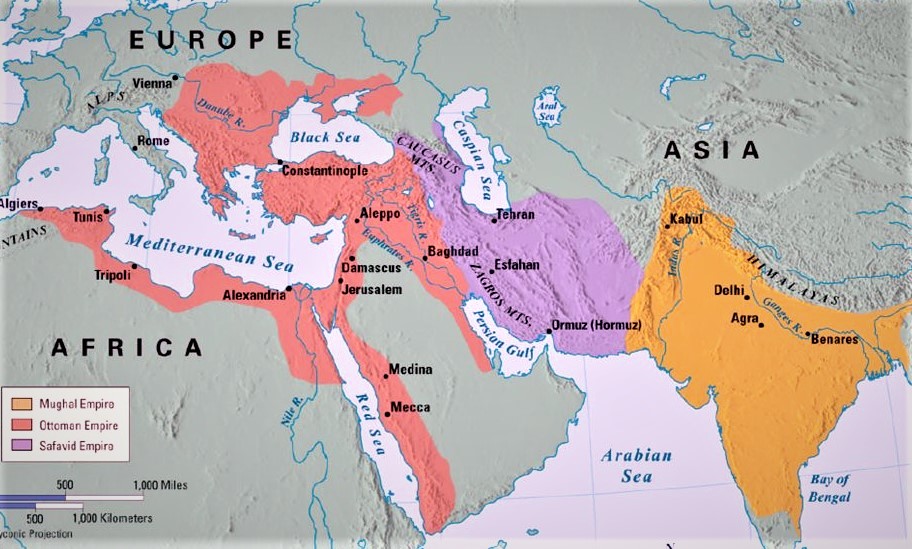Chapter One : Foundations of the Modern Middle East
Part 5. The Great Islamic Empires
The period of the Gunpowder Empires was a time when the continued dominance of Turkish states in the Middle East came to its logical conclusion. The Ottoman and Safavid empires both began in Anatolia and managed to establish their authority as Turkish elites ruling over non-Turkish majorities for several hundred years. They would eventually adopt opposing religious ideologies (Sunni Islam for the Ottomans, Shi`a Islam for the Safavids) and would become arch-rivals for a couple hundred years until the collapse of the Safavids in 1736. The Ottoman Empire would last until the twentieth century, although it was continuing to weaken from the late eighteenth century on.
The Ottoman Empire arose in the aftermath of the Mongol conquests. The Mongols, and their successor Timur Leng, left a collection of local Turkish regimes in Anatolia that competed with one another for authority in the region. The regime that would eventually emerge out of this competition was a group known as the Osmanlis, named after the founder of the dynasty, Osman. In the early fourteenth century, Osman established an emirate based in the city of Sogut in northwestern Anatolia. From the very beginning, the Ottomans (as they would be called by Westerners) dealt extensively with Christians, and most of their earliest conquests came at the expense of the Christian Byzantine Empire.
By the mid-fourteenth century, the Ottomans would expand their territory to the European side of the Dardanelles, the long strait that separates Anatolia from southeast Europe. In fact, Ottoman power would be based as much on their possession of the Balkans as on any of their possessions in Anatolia. The earliest Ottoman sultans to establish their authority in Europe made alliances with Christian princes in the Balkans, but by the end of the fourteenth century, Ottoman sultans would simply conquer the Christian principalities and implement Ottoman rule. It was the Ottoman possession of the Balkans that allowed them to withstand a devastating defeat in Anatolia at the hands of Timur Leng in 1402. Not only did the Ottomans recover from this blow, but they had brought the rest of Anatolia, including the city of Constantinople, into their empire by the end of the fifteenth century.
The high point of Ottoman success is usually identified as being the period between the beginning of the reign of Mehmet II (the Conqueror) in 1451 through the end of the reign of Suleyman the Magnificent in 1566. During this time the Ottomans’ military recruitment system, the devshirme, through which they enslaved Christian boys from the Balkans, converted them to Islam, and raised them up to be elite infantry troops, was paying rich dividends. In addition to Constantinople, the Ottomans conquered Syria, Egypt, North Africa, Iraq, Bosnia, Hungary and Transylvania. In fact, the Ottomans appeared to be an imminent threat to the European city of Vienna by the mid sixteenth century. The Austrian diplomat, Ogier Ghiselin de Busbecq, who spent extended time in the Ottoman capital, drew grim conclusions regarding the future of Europe from observing the coordination and discipline of Ottoman troops.
Busbecq was convinced that the Ottomans were on the cusp of overrunning Western Europe. In this regard, he wrote the following: “It makes me shudder to think of what the result of a struggle between such different systems must be; one of us must prevail and the other be destroyed, at any rate we cannot both exist in safety. On their side is the vast wealth of their empire, unimpaired resources, experience and practice in arms, a veteran soldiery, an uninterrupted series of victories, readiness to endure hardships, union, order, discipline, thrift, and watchfulness. On ours are found an empty exchequer [treasury], luxurious habits, exhausted resources, broken spirits, a raw and insubordinate soldiery, and greedy generals; there is no regard for discipline, license runs riot, the men indulge in drunkenness and debauchery, and, worst of all, the enemy are accustomed to victory, we, to defeat. Can we doubt what the result must be? The only obstacle is Persia, whose position on his rear forces the invader to take precautions. The fear of Persia gives us a respite, but it is only for a time. When he has secured himself in that quarter, he will fall upon us with all the resources of the East. How ill prepared we are to meet such an attack it is not for me to say.”
The arch-rivals of the Ottomans in the Islamic world were the Safavid Empire of Persia. An offshoot of a Turkish Sufi order, the Safavids eventually converted to Shi`a Islam. After uniting Persia under their authority in the early sixteenth century, the Safavids forcibly converted the Persian people to their form of Islam (Twelver Shi`ism), making themselves into a true ideological rival for the Sunni Ottomans. The Ottomans and Safavids fought many wars, mostly over control of Iraq and Azerbaijan, during the sixteenth and seventeenth centuries. Under Shah Abbas (r. 1588-1629) the Safavids drove back the Ottoman armies and conquered Baghdad in 1624 only to lose it again in 1638. Following the death of Abbas, the Safavids went into decline and the empire came to an end when it was conquered by Nader Shah, ruler of the rival Persian Afsharid dynasty. In contrast, the Ottoman Empire lasted until the early twentieth century, finally being dismantled by the triumphant Western powers following the end of World War I.
There is no question that the Ottoman Empire ranks among the great empires in the history of the world. At its height, it managed to rule over such contested areas as Iraq, Palestine and the Balkans with a minimum of trouble. The fall of the empire in the aftermath of World War I created turmoil in the Middle East that the region has yet to recover from.


